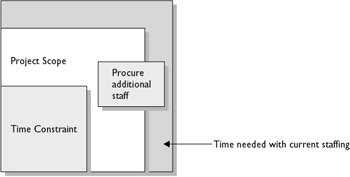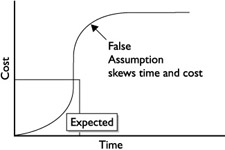Planning for Procurement
|
| < Day Day Up > |
|
Procurement planning is the process of identifying which part of the project should be procured from resources outside of the organization. Generally, procurement decisions are made early on in the planning processes. Procurement planning centers on four elements:
-
Whether or not procurement is needed
-
What to procure
-
How much to procure
-
When to procure
Referring to the Scope Statement
The project's scope statement serves as input to making procurement decisions. Because the project scope statement defines the project work, and only the required work, to complete the project, it also defines the limitations of the project. Knowing these limits of what the project includes can help the project manager, the contract specialists, or other procurement professional, determine what needs to be purchased and what does not.
Referring to the Product Description
The product description defines the details and requirements for acceptance of the project. This information also serves as valuable input to what needs to be procured-and to what does not. The product description defines what the end result of the project will be. When dealing with vendors to procure a portion of the project, the work to be procured must support the requirements of the project customer.
A statement of work (SOW) may define the work to be accomplished within the project, but it generally does not define the product description as a whole. However, when an entire project is to be procured from a vendor, the SOW and the product description become one and the same.
Relying on Procurement Resources
Often an organization will have resources for managing the procurement process, including contracting and negotiating on behalf of the project. If, however, the performing organization has no such resources for the project manager to rely upon, then it is up to the project manager to supply the procurement management resources, including capabilities for negotiating and for obtaining in a fiscally responsible way the right products or services for a fair price on behalf of the performing organization.
Evaluating the Market Conditions
Part of procurement management is to determine what sources are available to provide the needed products or services for the project. An evaluation of the marketplace is needed to determine what products and services are available and from whom and on what terms and conditions they are available.
While in most free market enterprise societies there are multiple vendors offering comparable products, there may be times when choices of vendors are limited. There are three specific terms to know for the PMP exam that you may encounter:
-
Sole source Only one qualified seller exists in the marketplace.
-
Single source The performing organization prefers to contract with a specific seller.
-
Oligopoly There are very few sellers and the actions of one seller will have a direct effect on the other seller's prices and the overall market condition.
Evaluating Assumptions, Constraints, and Other Factors
The project assumptions and constraints can have direct influence on the procurement process. For example, a project with a time constraint to complete a project by a given deadline may be forced to procure additional laborers to complete portions of the project work in order to complete the project as scheduled

Assumptions can also affect procurement decisions. A false assumption that the installation of a piece of equipment was part of the quoted price could skew the project's budget. Assumptions, especially in procurement planning, must be eliminated if at all possible.

Other factors must also be considered to have effective procurement planning:
-
Cost estimates
-
Schedule estimates
-
Quality management requirements
-
Cash flow projections
-
WBS components
-
Risk management plans
-
Staff acquisitions and development
|
| < Day Day Up > |
|
EAN: 2147483647
Pages: 209